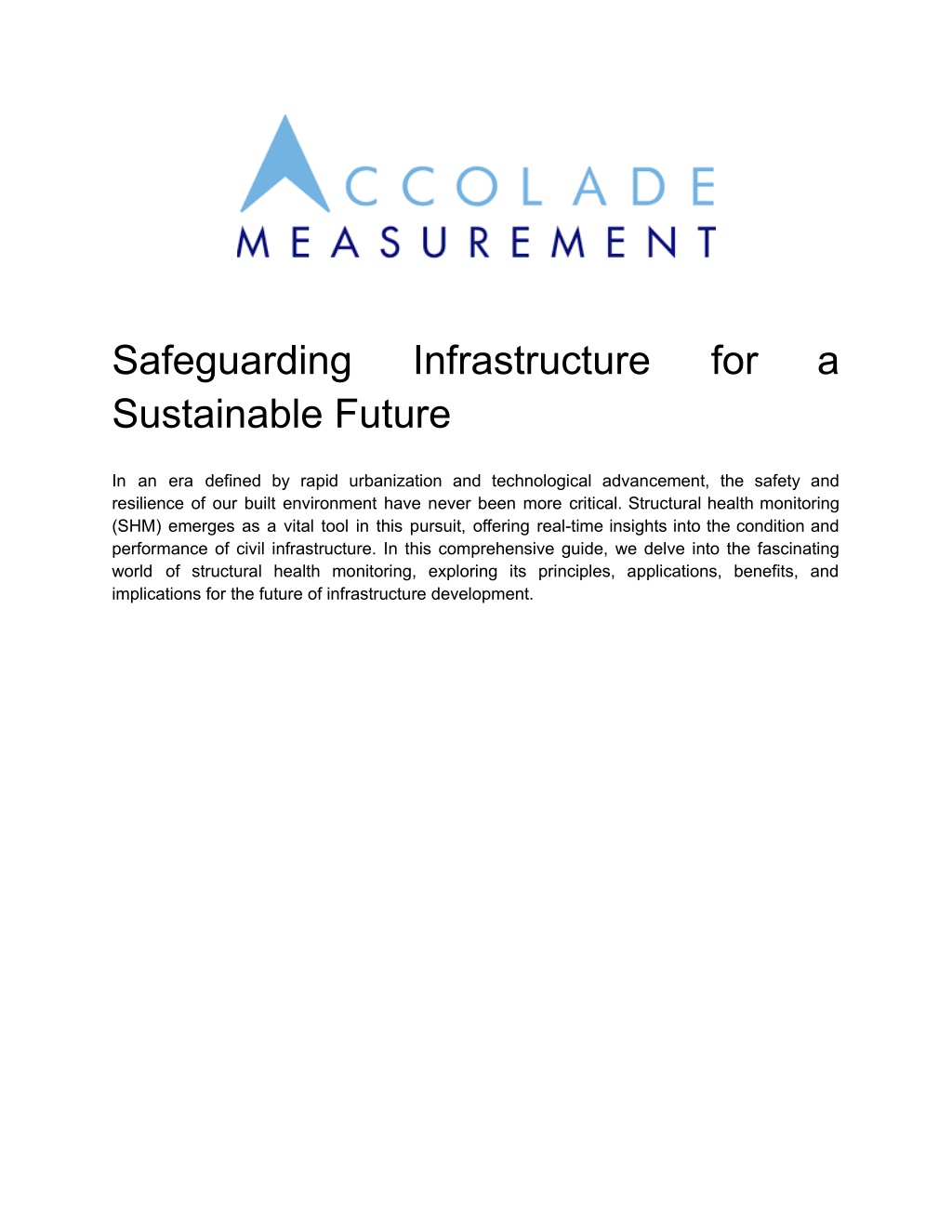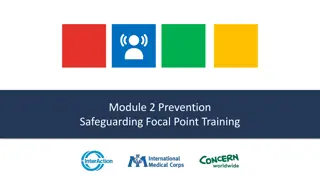
Safeguarding Infrastructure for a Sustainable Future
Ensuring infrastructure sustainability involves adopting renewable energy, efficient designs, and materials that minimize environmental footprint and promote longevity.
Download Presentation

Please find below an Image/Link to download the presentation.
The content on the website is provided AS IS for your information and personal use only. It may not be sold, licensed, or shared on other websites without obtaining consent from the author. Download presentation by click this link. If you encounter any issues during the download, it is possible that the publisher has removed the file from their server.
E N D
Presentation Transcript
Safeguarding Sustainable Future Infrastructure for a In an era defined by rapid urbanization and technological advancement, the safety and resilience of our built environment have never been more critical. Structural health monitoring (SHM) emerges as a vital tool in this pursuit, offering real-time insights into the condition and performance of civil infrastructure. In this comprehensive guide, we delve into the fascinating world of structural health monitoring, exploring its principles, applications, benefits, and implications for the future of infrastructure development.
Understanding Structural Health Monitoring: Structural health monitoring (SHM) encompasses a suite of techniques and technologies designed to assess the condition, performance, and integrity of civil infrastructure such as buildings, bridges, dams, and pipelines. By continuously monitoring structural behavior and performance, SHM systems provide early warning of potential defects, deterioration, or damage, enabling timely intervention and maintenance to prevent catastrophic failure. Principles of Structural Health Monitoring: At the heart of structural health monitoring lies the integration of sensors, data acquisition systems, and analytical tools to collect, process, and analyze structural performance data in real time. These sensors, which may include accelerometers, strain gauges, displacement sensors, and acoustic emission sensors, measure various parameters such as vibration, deformation, and stress to assess structural health and detect anomalies.
Applications of Structural Health Monitoring: Structural health monitoring finds applications across a wide range of civil infrastructure sectors, including transportation, energy, water resources, and telecommunications. In the transportation sector, SHM systems are used to monitor the health of bridges, tunnels, railways, and highways, ensuring safe and efficient transportation networks. In the energy sector, SHM techniques are employed to assess the integrity of power plants, offshore platforms, and wind turbines, optimizing asset performance and minimizing downtime. Benefits of Structural Health Monitoring: The adoption of structural health monitoring offers numerous benefits to infrastructure owners, operators, and stakeholders. By providing real-time insights into structural behavior and performance, SHM systems enable proactive maintenance, minimizing downtime and repair costs while extending the lifespan of assets. Additionally, SHM enhances safety by identifying potential risks and hazards before they escalate into emergencies, protecting lives and property. Structural health monitoring (SHM) offers a wide array of benefits across various sectors, including civil engineering, transportation, energy, and aerospace. Let's delve into the significant advantages of implementing SHM systems: Early Detection of Structural Issues: One of the primary benefits of SHM is its ability to detect structural issues at an early stage, before they escalate into critical problems. Continuous monitoring using sensors allows for the identification of minor defects, cracks, or deformations, enabling timely intervention and maintenance. Improved Safety and Reliability: By providing real-time insights into the condition and performance of structures, SHM enhances safety for occupants and users of infrastructure. Early detection of potential hazards helps prevent accidents, minimize risks, and ensure the reliability and integrity of critical assets. Cost Savings: Proactive maintenance based on SHM data can result in significant cost savings by preventing expensive repairs and minimizing downtime. By addressing issues promptly, SHM helps extend the lifespan of structures and reduces the need for costly replacements or major rehabilitation projects. Enhanced Asset Management:
SHM systems facilitate condition-based maintenance strategies, allowing asset managers to prioritize maintenance activities based on actual structural health data. By optimizing maintenance schedules and resource allocation, SHM helps maximize the efficiency and effectiveness of asset management practices. Increased Operational Efficiency: With SHM providing real-time monitoring and diagnostics, operators can make informed decisions about the operation and maintenance of infrastructure assets. By optimizing performance and reducing downtime, SHM contributes to increased operational efficiency and productivity across various sectors. Environmental Sustainability: By promoting proactive maintenance and minimizing the need for large-scale repairs or replacements, SHM supports environmental sustainability efforts. Extending the lifespan of infrastructure assets reduces the environmental impact associated with construction, demolition, and material disposal. Enhanced Resilience to Extreme Events: SHM systems can help improve the resilience of structures to extreme events such as earthquakes, hurricanes, or floods. By providing early warning of potential structural vulnerabilities, SHM enables proactive measures to mitigate risks and enhance the resilience of infrastructure systems. Data-Driven Decision Making: SHM generates vast amounts of data on structural performance, which can be analyzed to gain valuable insights into asset behavior and trends. Data-driven decision-making based on SHM data allows stakeholders to optimize design, construction, and maintenance practices, leading to more informed and effective decisions. Compliance with Regulatory Requirements: Many industries, such as transportation and energy, are subject to regulatory requirements related to infrastructure safety and performance. SHM systems help organizations comply with regulatory standards by providing documentation of structural health and maintenance activities. Innovation and Technological Advancement: The development and implementation of SHM systems drive innovation and technological advancement in the field of civil engineering and structural monitoring. Ongoing research and development efforts in SHM lead to the creation of new sensors, algorithms, and monitoring techniques, pushing the boundaries of what is possible in infrastructure monitoring and maintenance.
Implications for Sustainable Infrastructure Development: In an era of increasing urbanization and environmental challenges, the importance of sustainable infrastructure development cannot be overstated. Structural health monitoring plays a pivotal role in this endeavor by promoting resilience, efficiency, and longevity in civil infrastructure systems. By enabling predictive maintenance and condition-based asset management, SHM contributes to resource conservation, energy efficiency, and environmental sustainability. Challenges and Future Directions: Despite its many advantages, structural health monitoring faces several challenges, including cost, complexity, and data management issues. Addressing these challenges requires continued innovation and collaboration among researchers, practitioners, and policymakers. Looking ahead, the future of structural health monitoring holds exciting possibilities, with advances in sensor technology, data analytics, and artificial intelligence poised to revolutionize the field and enhance the safety, reliability, and sustainability of our built environment.
Conclusion: Structural health monitoring represents a powerful tool for safeguarding the integrity and resilience of civil infrastructure in an increasingly complex and interconnected world. By providing real-time insights into structural performance, SHM systems enable proactive maintenance, enhance safety, and promote sustainability in infrastructure development. As we continue to confront the challenges of urbanization, climate change, and technological disruption, the adoption of structural health monitoring from Accolade Measurement will be instrumental in shaping a safer, more resilient, and sustainable future for generations to come.






















